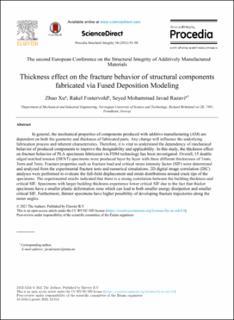| dc.contributor.author | Xu, Zhuo | |
| dc.contributor.author | Fostervold, Rakel | |
| dc.contributor.author | Razavi, Seyed Mohammad Javad | |
| dc.date.accessioned | 2022-02-16T12:59:15Z | |
| dc.date.available | 2022-02-16T12:59:15Z | |
| dc.date.created | 2022-01-11T08:26:59Z | |
| dc.date.issued | 2021 | |
| dc.identifier.citation | Procedia Structural Integrity. 2021, 34, 93-98. | en_US |
| dc.identifier.issn | 2452-3216 | |
| dc.identifier.uri | https://hdl.handle.net/11250/2979383 | |
| dc.description.abstract | In general, the mechanical properties of components produced with additive manufacturing (AM) are dependent on both the geometry and thickness of fabricated parts. Any change will influence the underlying fabrication process and inherent characteristics. Therefore, it is vital to understand the dependency of mechanical behavior of produced components to improve the designability and applicability. In this study, the thickness effect on fracture behavior of PLA specimens fabricated via FDM technology has been investigated. Overall, 15 double edged notched tension (DENT) specimens were produced layer by layer with three different thicknesses of 1mm, 3mm and 5mm. Fracture properties such as fracture load and critical stress intensity factor (SIF) were determined and analyzed from the experimental fracture tests and numerical simulations. 2D digital image correlation (DIC) analyses were performed to evaluate the full-field displacement and strain distributions around crack tips of the specimens. The experimental results indicated that there is a strong correlation between the building thickness and critical SIF. Specimens with larger building thickness experience lower critical SIF due to the fact that thicker specimens have a smaller plastic deformation zone which can lead to both smaller energy dissipation and smaller critical SIF. Furthermore, thinner specimens have higher possibility of developing fracture trajectories along the raster angles. | en_US |
| dc.language.iso | eng | en_US |
| dc.publisher | Elsevier Science | en_US |
| dc.rights | Attribution-NonCommercial-NoDerivatives 4.0 Internasjonal | * |
| dc.rights.uri | http://creativecommons.org/licenses/by-nc-nd/4.0/deed.no | * |
| dc.title | Thickness effect on the fracture behavior of structural components fabricated via Fused Deposition Modeling | en_US |
| dc.type | Peer reviewed | en_US |
| dc.type | Journal article | en_US |
| dc.description.version | publishedVersion | en_US |
| dc.source.pagenumber | 93-98 | en_US |
| dc.source.volume | 34 | en_US |
| dc.source.journal | Procedia Structural Integrity | en_US |
| dc.identifier.doi | 10.1016/j.prostr.2021.12.014 | |
| dc.identifier.cristin | 1977960 | |
| cristin.ispublished | true | |
| cristin.fulltext | original | |
| cristin.qualitycode | 1 | |

